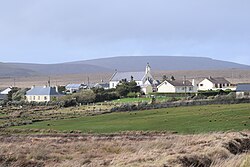Curraunboy (Irish: An Corrán Buí;[1] also known as Cornboy, meaning "yellow crescent")[2] is a Gaeltacht village and townland in northwest County Mayo, Ireland. It is situated in the barony of Erris and civil parish of Kilcommon. Curraunboy townland has an area of approximately 2844 acres (11.51 km²)[3] and, as of 2011, had a population of 76 people.[4]
Curraunboy
An Corrán Buí Cornboy | |
|---|---|
Townland | |
 Curraunboy village | |
| Coordinates: 54°18′02″N 9°46′18″W / 54.3006°N 9.77158°W | |
| Country | Ireland |
| Province | Connacht |
| County | County Mayo |
| Area | |
• Total | 11.5076 km2 (4.4431 sq mi) |
| Elevation | 28 m (92 ft) |
| Population (2011) | |
• Total | 76 |
| • Density | 6.6/km2 (17/sq mi) |
| Time zone | UTC+0 (WET) |
| • Summer (DST) | UTC-1 (IST (WEST)) |
| Irish Grid Reference | F84716 40536 |
| As this is a Gaeltacht village An Corrán Buí is the only official name. The anglicised spellings Curraunboy and Cornboy have no official status. | |
History
editRemains of potential Iron Age settlement is recorded in an area known as the Sandhills. The sand buried the huts again until they were revealed by another storm in 1903. This settlement, northwest of the pier included numerous buildings and middens containing periwinkle and cockles.[2]
Fr. Sean Noone in Where The Sun Sets notes that William Bald's 1812 map shows a small group of eight houses, originally, the residents here lived closer to the Cornboy pier at Broadhaven Bay, close to an old church on a hill, but were forced to relocate due to sands that were starting to cover the settlement.[2] Cornboy Pier was erected in 1887.[2]
A storm in 1911 blew away the roof of the old church and severely damaged its walls.[2] The 1920 Ordnance Survey refers to a settlement approximately 200 yards inland from the old Cornboy pier. Thomas Johnson Westropp, who investigated this site around 1912, reported that locals claimed it had been uncovered by a storm, likely the 1839 Night of the Big Wind.[2][5]
Geography
editThe Gweedaney River that originates in Portacloy flows through the townland. The townland consists of an area of dunes, farms and mountain bog.[2]
Religion
editThe Catholic Church of Our Lady, Star of the Sea built between 1912 and 1913 and dedicated in 1914, is the local parish church. Elements include pitched slate roofs, round-headed doors and windows with stained glass, and a bell-cot.[6]
The interior has a central aisle, timber pews, and an alabaster altar. The church retains much of its original design and fabric, and has been described as an example of early 20th-century Romanesque architecture.[6]
Amenities
editThere is a 9 km walk, the "Cornboy Loop" that passes through the townland.[7] There is a community centre and cemetery in the village.
See also
editReferences
edit- ^ "An Corrán Buí/Curraunboy". logainm.ie. Retrieved 2024-07-22.
- ^ a b c d e f g Noone, Fr. Sean (1991). Where The Sun Sets (1st ed.). Ballina: Erris Publications. pp. 162–166. ISBN 0951817906.
- ^ "Curraunboy Townland, Co. Mayo". www.townlands.ie. Retrieved 2024-07-22.
- ^ "CD164 - Mayo Population by Private Households, Occupied and Vacancy Rate". data.gov.ie. Central Statistics Office. Retrieved 22 July 2024.
Population [..] Townlands [..] Curraunboy, Knockadaff, Co. Mayo [..] 76
- ^ Westropp, Thomas Johnson (1912). "The Promontory Forts and Early Remains of the Coasts of County Mayo. Part I. The North Coast (Tirawley and Erris) (Continued)". The Journal of the Royal Society of Antiquaries of Ireland. 2 (2): 129–130. ISSN 0035-9106.
- ^ a b FUSIO. "Catholic Church of Our Lady Star of the Sea, CURRAUN BOY, Corrán Buí [Curraunboy], MAYO". Buildings of Ireland. Retrieved 2024-07-22.
- ^ "Cornboy Loop, Walks in Co. Mayo West of Ireland | mayo-ireland.ie". www.mayo-ireland.ie. Retrieved 2024-07-23.
